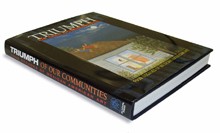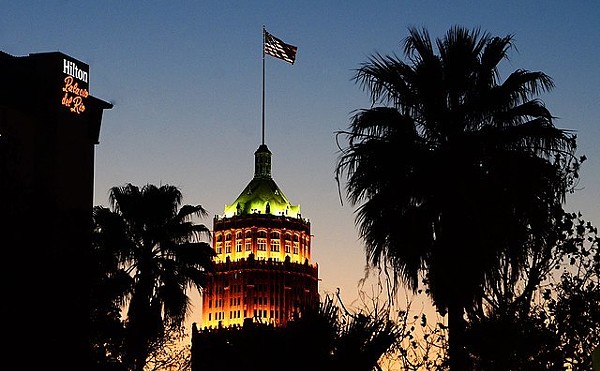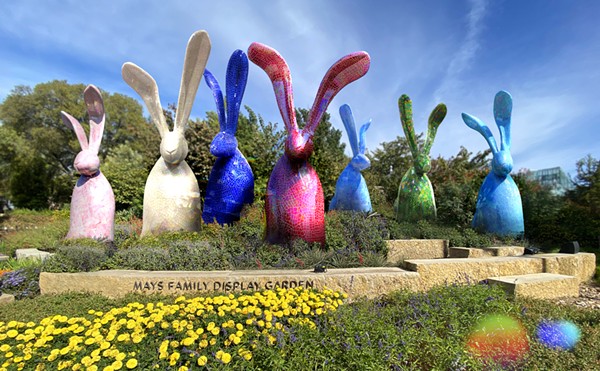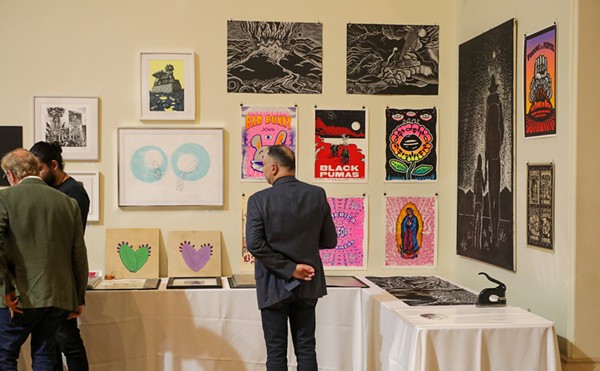| |
I suppose that when someone utters the phrase "cowboy art," the painter Frederic Remington might come to mind, or perhaps the three-stories-tall Chisholm Trail Mural by Richard Haas that dominates Fort Worth's Sundance Square. I think of an unholy Texas trinity: minimalist sculptor Donald Judd, who discovered a use for scrubland devoid of cattle; critic Dave Hickey, who is neither a cowboy nor an artist but writes about art as if he has the biggest steed in the corral; and Terry Allen, who is borderline indescribable except as a wild-card jack of all trades.
Texas is a large state, but if its borders defy the speed of the automobile, its arts community has, until recently, been easily charted, the luminaries glowing brightly like beacons from each city across the vast stretches, signaling and luring one another. This may explain why Allen, whose visual art is middling (it is sometimes unintelligibly conceptual; other times too flatly representational), is a Texas art legend, his spirit always hovering in the ether over Dallas, Houston, Austin, and San Antonio. But Allen has transcended the boundaries of the state, too. His work is in the Metropolitan Museum of Art, and he has received Guggenheim and NEA fellowships.
A more likely explanation for Allen's enduring popularity is that he is a great storyteller who uses a variety of mediums to share the sort of insights that come from a life that sounds like a Depression-era, Texas Panhandle, Life Magazine cliché: His father was a baseball player, his mother a retired dancehall pianist. The University of Texas Press has just released Dugout, a compilation of a three-part body of work that tells the story of Allen and his parents' life with the same joyful, experiential delirium that Allen Ginsberg's "Witchita Vortex Sutra" uses to render Kansas the touchstone of America's Atomic age. It reveals definitively that Allen, who is rightfully famous for his music (his sings like a vehicle on a gravel road: sometimes an old Chevy carefully negotiating the curves, sometimes a semi that's lost the emergency brake on a downgrade), is a wordsmith above all else. An excerpt from Dugout III: Warboy and the Backboard Blues:
"Out in the backyard / Beneath the stars / He's just another John Wayne / In one of his wars / Or shooting baskets in the big spotlight / He is the great Bob Cousey tonight / But he can hear the party / Going on / In the house / And there's Atomic / Honky Tonk strangeness / In the house."
The hour-long CD recording of Warboy that accompanies the book reinforces the impression that Allen's true vocation is spinning timeless yarns using all of the tools at a modern man's disposal. The word "dugout" is a powerful metaphor for the many themes Allen is jerry-rigging together, from hardscrabble pioneer life to Cold War bomb scares to America's former pastime. Allen's lyrics and prose are up to the task without the accompanying art, but as Nicholas Mirzoeff observes in Visual Culture: An Introduction, "Modern life takes place onscreen."
| |
|
Dugout The Nineteenth-Century Visual Culture Reader Triumph of Our Communities: |
If you prefer a narrative, utilitarian version of visual culture, Bilingual Press can answer the call with Triumph of Our Communities: Four Decades of Mexican American Art, the fourth entry in a series that includes the two-volume Contemporary Chicana and Chicano Art and Chicano Art for Our Millennium: Collected Works from the Arizona State University Community. Triumph is the largest of the collection at 11 by 14 inches, all the better for showcasing the hundreds of images grouped loosely around community arts organizations such as San Antonio's 1906 Gallery, Gallista Gallery, and Guadalupe Cultural Arts Center. The work of Jesse Trevino, Vincent Valdez, and Angel Rodriguez-Diaz is gorgeously reproduced here along with Chicano art from across the country. Text is kept to a minimum in the book, but can be found on an accompanying CD because the images themselves - such as a giant centerfold of Omar Ramírez and Chaz Bojórquez' serigraph for "The Here and Now" - are the story, and the story they tell is of the triumph of the image. •
By Elaine Wolff

















